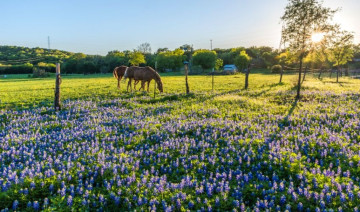
Spring Grazing: Top Tips for Nourishing Your Horse as Seasons Change
As winter bids farewell and the vibrant hues of spring unfold, horse owners embark on a crucial transition in their equine care routines. Spring is a season of renewal and growth, and ensuring your horse receives the right nutrition during this period is essential for their health and vitality. In this blog, we'll explore top tips for feeding your horse this spring, guiding you through the nutritional considerations that accompany the blossoming of a new season.
1. Evaluate Pasture Conditions:
Before adjusting your horse's diet, assess the state of your pasture. Spring grass is rich in nutrients, but its sugar content can vary. Be mindful of the risk of laminitis, especially in horses prone to metabolic issues. Gradually introduce grazing to allow your horse's digestive system to adapt.
2. Slow Transition to Spring Pasture:
To prevent digestive upsets, introduce your horse slowly to spring pasture. Start with short grazing sessions and gradually increase the time as their system adjusts. This method helps avoid issues such as colic or laminitis associated with abrupt changes in diet.
3. Supplement with Quality Forage:
While spring grass is lush, it's crucial to supplement with quality forage to ensure a balanced diet. Hay provides essential fiber and helps regulate digestion. Adjust the hay quantity based on the nutritional content of your pasture and your horse's individual needs.
4. Review Grain and Concentrates:
Assess your horse's grain and concentrate requirements based on their activity level, age, and overall health. Spring often brings increased activity, so adjusting the energy content of their diet may be necessary. Consult with a veterinarian or equine nutritionist to fine-tune their grain intake.
5. Ensure Proper Hydration:
As temperatures rise, adequate hydration becomes more critical. Ensure your horse has constant access to clean, fresh water. Consider adding electrolytes to their diet, especially if they are working or sweating more than usual.
6. Monitor Weight and Body Condition:
Spring is a season of renewal, and horses often shed their winter coats. Monitor your horse's weight and body condition, adjusting their diet accordingly. A balance between maintaining a healthy weight and providing adequate nutrition is key.
7. Regular Health Check-ups:
Schedule a veterinary check-up in the spring to assess your horse's overall health. This is an opportune time to discuss any changes in diet, address concerns, and ensure your horse is on track for a healthy season.
8. Consider Seasonal Supplements:
Depending on your horse's specific needs, consider incorporating seasonal supplements. These could include vitamins, minerals, or joint supplements, providing targeted support as your horse becomes more active in the spring.
9. Watch for Allergies:
Spring can bring about allergies in horses, including respiratory issues. Monitor your horse for signs of allergies such as coughing or nasal discharge. Consult with your veterinarian if you suspect any respiratory concerns.
10. Adjust Diet to Individual Needs:
Every horse is unique, and their nutritional needs may vary. Pay attention to your horse's individual response to diet changes. Adjustments might be necessary based on their health, activity level, and any specific conditions they may have.
As spring breathes new life into the world, make sure your horse's nutrition aligns with the seasonal changes. By carefully managing their diet, gradually transitioning to spring pasture, and addressing individual needs, you set the stage for a season of health, vitality, and joyful companionship with your equine friend. Always consult with equine professionals for personalized guidance based on your horse's unique requirements.
